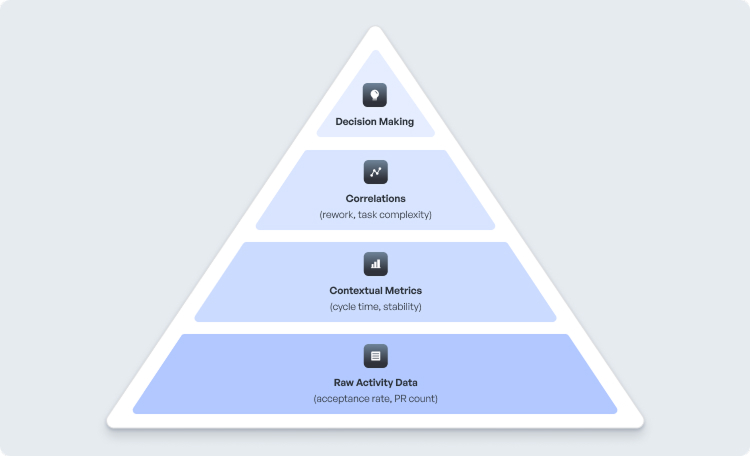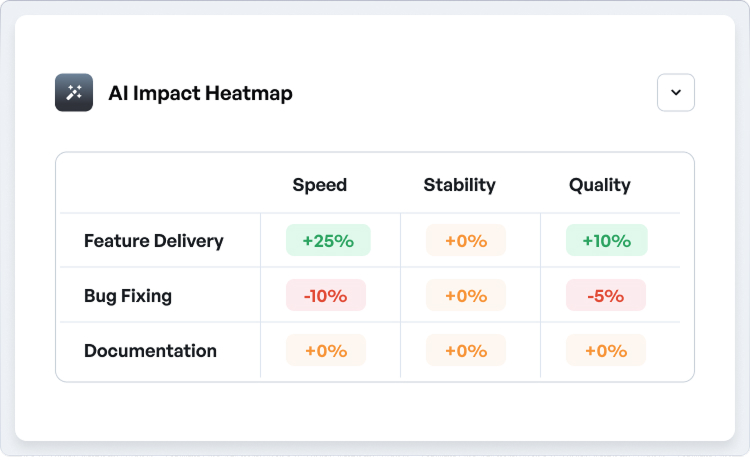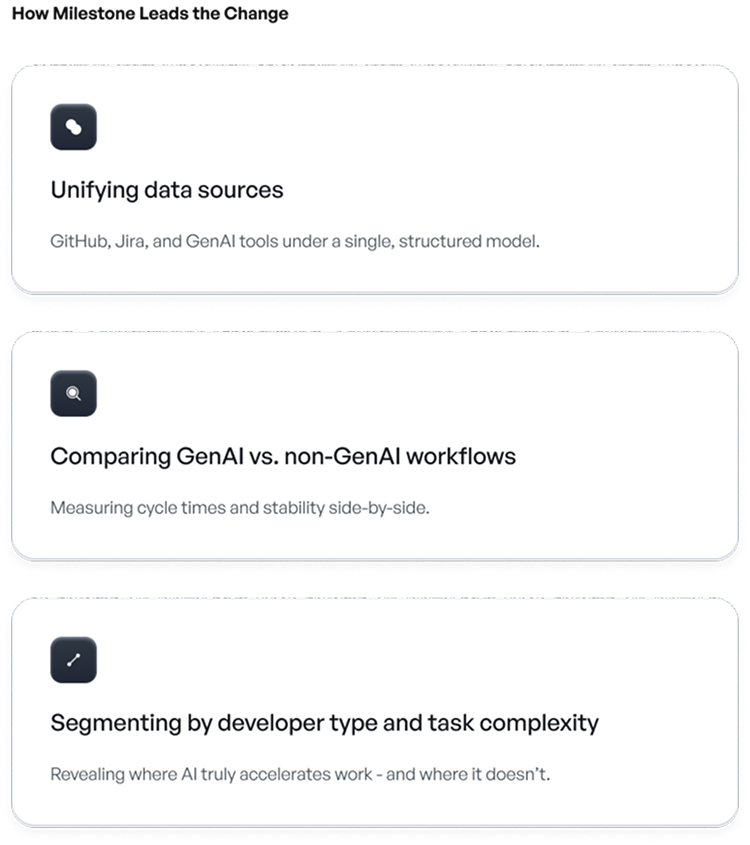Data is everywhere in modern software development. Every commit, pull request, Jira ticket, and AI code suggestion adds another row to an already overflowing database of “developer activity.”
But for all the data we collect, how often does it actually help leaders make better decisions?
Too many organizations are data-rich, but insight-poor. Right now, they know full well that their teams are using GitHub Copilot or Cursor. They can count code suggestions, log velocity trends, and measure pull request sizes. Sounds like a pretty solid grasp of how teams are operating, correct?
However, what they can’t answer with confidence is:
- Are AI tools really saving time across the board?
- Which workflows or developer profiles benefit most?
- How do AI-driven changes impact long-term code quality and stability?

The truth is, most engineering metrics are descriptive. They tell you what happened, but not why it happened or what to do next. You’re only getting a part of the bigger picture, and not necessarily set within a wider context or presented in a way that connects the dots together to form meaningful and valuable insights.
Not for long. The next era of engineering intelligence is changing that approach as we speak, shifting from dashboards that report on activity to platforms that guide strategy. The days of static data in spreadsheet tables are quickly falling behind us – opening the way for dynamic, easy-to-access, and highly readable insights to take center stage.
The Data Problem: Plenty of Metrics, Somewhat Little Meaning
The truth is, engineering teams have never had more data available to them. Between Git, Jira, testing suites, and now GenAI tooling, the volume of information is staggering. But fragmented, surface-level metrics rarely deliver actionable value. It’s becoming harder to cut through the static and find the signal.
Take AI coding assistants as an example. Seeing a 70% suggestion acceptance rate sounds promising, but does it mean developers are truly faster? Without tying that data to cycle time, rework rates, and task complexity, it’s just noise.

This lack of context is a blind spot. Organizations risk spending millions scaling tools they think are helping, or missing opportunities to double down where AI is truly driving results. In a GenAI era, where workflows are changing fast, intuition isn’t enough. You need facts and correlations, plain and simple.
The Shift: From Tracking Activity to Measuring Outcomes
The future of engineering intelligence will be defined by outcome-driven analytics. This means connecting activity data to the metrics that matter for productivity, quality, and delivery speed, giving you a holistic and real-world view of usage.
Platforms like Milestone are leading this change by:
- Unifying data sources: GitHub, Jira, and GenAI tools under a single, structured model.
- Comparing GenAI vs. non-GenAI workflows: Measuring cycle times and stability side-by-side.
- Segmenting by developer type and task complexity: Revealing where AI truly accelerates work – and where it doesn’t.
Instead of counting suggestions or commits, teams gain visibility into real impact: how GenAI shifts timelines, improves (or hurts) code stability, and not only changes the way software gets delivered. It changes how you make decisions about the future of your operations and development.
This is analytics that moves beyond conventional, run-of-the-mill reporting to intelligently and accurately inform strategy.
The Strategic Layer: Turning Insights into Decisions
Engineering leaders don’t just want more dashboards and mountains of numbers. They need clarity on where to invest time, money, and talent. This next generation of engineering intelligence provides that strategic layer, and transforms the way decisions are being discussed – and then made.
Imagine seeing this insight:
- GenAI tools improve feature delivery speed by 25% in one team, but bug resolution actually slows down by 10%.
With that data, leaders can make more targeted choices than before: they’ll refine processes, invest in training, or adjust AI usage policies, instead of rolling out blanket adoption strategies. They can make laser-focused adjustments per team (or even individual) that have actual, measurable impact.
Think of it like this – if you’re a teacher and you notice your students’ grade point average going down, your first thought might be that you need to change the curriculum to adjust to the learning level. However, with more focused adjustments, you might find that what you actually need is a change of teaching methods for particular students, or an adjusted environment that addresses the lower performing group’s needs in a better way.
The new age of engineering intelligence helps to make GenAI an actual added value to your organization, but only where it’s truly needed. You just need the insights to make the right decisions.
Milestone’s vision is to make these decision points accessible through:
- Self-serve dashboards: Customizable views for every leader and team.
- Advanced segmentation: Insights broken down by developer profile, project type, or workflow.
- Custom metrics: Alignment with company-level OKRs, not vanity metrics.
The goal isn’t just to see what happened – it’s to understand why it happened and what to do next.

The Future: Predictive, Proactive, Strategic
As GenAI reshapes software engineering, the organizations that win won’t just deploy tools, they’ll deploy intelligence layers that guide their use. Those in the loop know that the future of engineering analytics is:
- Proactive: Spotting opportunities and risks early.
- Predictive: Forecasting delivery outcomes, not just tracking past ones.
- Strategic: Helping leaders make calls about tooling, hiring, and processes based on real data, not gut feel.
That’s where Milestone is headed: transforming fragmented engineering data into clear, actionable insights that give teams the confidence to scale GenAI responsibly and effectively.
Because at the end of the day, data without direction is just noise. The next frontier of engineering intelligence turns it into advantage.
Ready to go beyond dashboards and understand the real impact of GenAI on your engineering organization? Discover how Milestone transforms data into strategic decision-making.


